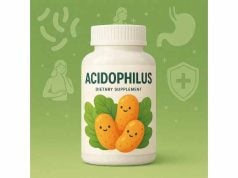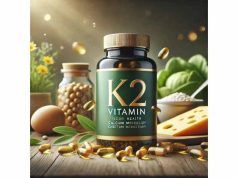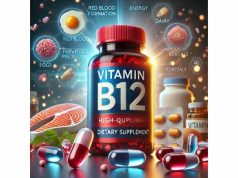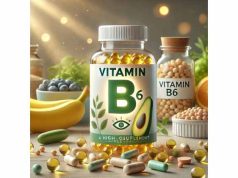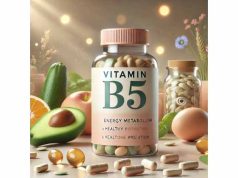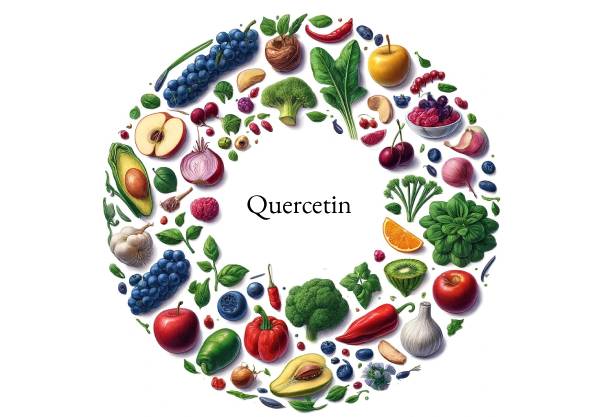
Quercetin, a bioflavonoid abundant in many fruits and vegetables, has garnered attention for its profound antioxidant and anti-inflammatory effects. Beyond its typical acclaim for cardiovascular and immune support, recent insights suggest that quercetin may also bolster ocular health. By neutralizing harmful free radicals, aiding tear stability, and potentially moderating intraocular pressure, this powerful plant compound appears to lend crucial protection to various eye structures. Whether you’re looking to ease digital eye fatigue, fortify aging eyes, or simply maintain sharper vision, quercetin can be a pivotal addition to your routine. Below, we uncover how quercetin benefits vision, guidelines for effective supplementation, and the research grounding these claims.
Table of Contents
- Exploring Quercetin: Basic Overview and Key Traits
- Mechanisms by Which Quercetin Elevates Eye Function
- Core Eye Health Advantages from Quercetin
- Practical Methods to Utilize Quercetin for Optimal Vision
- Insights from Research Studies on Quercetin’s Ocular Impacts
- Frequently Asked Questions about Quercetin
- References and Sources
Exploring Quercetin: Basic Overview and Key Traits
Quercetin is a naturally occurring flavonoid present in a broad array of plant foods—onions, apples, berries, and leafy greens, among others. Revered for centuries in herbal traditions, this polyphenol has sparked modern scientific interest due to its capacity to quell inflammation and oxidative stress at the cellular level. These properties have encouraged researchers to investigate quercetin as a potential ally in managing everything from seasonal allergies to chronic inflammatory conditions.
Where It Originates
- Dietary Abundance
- Quercetin appears predominantly in the skins and peels of fruits and vegetables.
- Notably high concentrations reside in onions (especially red varieties), apples, and certain berries.
- Supplement Forms
- Commercially, quercetin is extracted from plant sources and formulated into powders or capsules, providing reliable dosage.
- Sometimes combined with vitamin C or bromelain, a synergy that may improve absorption and efficacy.
Key Properties and Functions
- Antioxidant Force: Quercetin scavenges free radicals, defending cells from reactive oxygen species that can injure membranes and proteins.
- Anti-Inflammatory Potential: By inhibiting enzymes like COX and lipoxygenase, it modulates inflammatory mediator release.
- Immune Response Regulation: Research shows quercetin influences immune signaling, beneficial for both general health and ocular comfort when addressing dryness or irritation.
Relevance to Eye Wellness
- Delicate Ocular Tissues
The retina, cornea, and lens are particularly vulnerable to oxidative harm due to high metabolic activity and light exposure. Quercetin’s antioxidant effect can mitigate these risks. - Tear Film and Inflammation Control
Chronic low-grade inflammation drives dryness and degenerative conditions. Quercetin can help calm these inflammatory surges and nurture tear stability.
Given these foundational traits, quercetin emerges as more than a simple antioxidant. For eye-care enthusiasts or those grappling with dryness, strain, or progressive conditions, it holds promise as a potent, multi-dimensional nutrient.
Mechanisms by Which Quercetin Elevates Eye Function
The eyes rely on a symphony of metabolic, vascular, and neural processes to maintain crisp and comfortable vision. Quercetin supports these processes through various intertwined pathways, delivering meaningful advantages to ocular health.
Minimizing Oxidative Damage
- Free Radical Neutralization
- Photoreceptors and the lens endure constant oxidative stress from light exposure. Quercetin’s ability to bind and neutralize free radicals curbs damage that fosters cataracts or macular decline.
- Its robust antioxidant profile outperforms many typical dietary compounds, making it especially significant in retina-rich diets.
- Regenerating Antioxidant Enzymes
- Some evidence indicates quercetin can elevate or preserve glutathione, superoxide dismutase, and catalase activities, fortifying the eyes’ defense against daily environmental stress.
Inflaming Inflammation in Ocular Tissues
- Cytokine and Mediator Moderation
- Quercetin modulates the release of TNF-α, IL-6, and other pro-inflammatory cytokines, essential in dryness, blepharitis, or retinopathy scenarios.
- This immunological balance fosters an environment conducive to stable tear film production and corneal health.
- Preventing Cellular Overreaction
- Conditions like allergic conjunctivitis involve hyperactive mast cells. Quercetin may reduce mast cell degranulation, mitigating ocular redness, itching, or watery eyes.
Supporting Vascular and Neural Circuitry
- Microcirculation Enhancement
- Proper retinal function hinges on steady blood flow delivering oxygen and nutrients. Quercetin’s vasoactive properties can encourage healthier circulation.
- Some data point to quercetin’s role in improving endothelial function, a boon for retinas that require robust vascular support.
- Neuroprotective Aspects
- By damping oxidative stress around optic nerve fibers, quercetin may indirectly shield them from degenerative conditions, like elevated intraocular pressure.
- Preliminary findings hint at synergy with factors crucial for photoreceptor regeneration.
Reducing Eye Strain and Dryness
- Modulating Ocular Surface Inflammation
- Digital eye strain often arises from dryness or mild corneal irritation. Quercetin’s anti-inflammatory potential can alleviate these low-level irritations.
- Combined with consistent blinking or dryness management techniques, it can significantly reduce daily discomfort.
- Possible Tear Film Stabilization
- Though more data are needed, some hypothesize quercetin might maintain healthy meibomian gland function by limiting local inflammation, thereby improving tear lipid layers.
Complementing Other Nutrients
- Carotenoids
- Lutein, zeaxanthin, or astaxanthin primarily filter harmful light, while quercetin’s antioxidant punch supports deeper cellular resilience, offering a complementary approach to preserving macular function.
- Omega-3 Fatty Acids
- Quercetin plus fish oil might yield better dryness management or reduced inflammatory signals, especially for contact lens wearers or heavy screen users.
Thus, quercetin’s synergy of neutralizing oxidative burdens, modulating immune overreaction, preserving vascular integrity, and potentially stabilizing tear functions underscores its potential as a holistic ally for ocular function. Next, we’ll explore how these mechanisms translate into real-world benefits for everyday vision.
Core Eye Health Advantages from Quercetin
By leveraging its comprehensive defense across multiple pathways, quercetin can yield tangible improvements or protective outcomes for various eye concerns. Below are some prime ways quercetin can manifest positive changes in ocular wellness.
1. Staving Off Age-Related Macular Degeneration (AMD)
- Slowing Oxidative Macular Damage
AMD arises from cumulative harm to the macula’s photoreceptors and supporting structures. Quercetin’s antioxidant vigor can hamper the processes leading to drusen accumulation, a hallmark of AMD. - Macular Stability
Through improved retinal blood flow and reduced inflammatory infiltration, quercetin provides a stable environment for the macula, potentially prolonging central vision clarity.
2. Reducing Dry Eye and Surface Irritation
- Inflammation Control
Chronic dryness is often fueled by mild inflammation in the meibomian glands or tear film. Quercetin’s immunomodulatory capacity soothes these irritations, enabling more consistent tear production. - Less Surface Damage
A calmer ocular surface fosters fewer microlesions and better tear film integrity, diminishing discomfort for contact lens users or those in air-conditioned spaces.
3. Supporting Diabetic or Hypertensive Retinopathy
- Better Microvascular Health
People with diabetes or high blood pressure risk retinopathy from compromised vessels. Quercetin’s vascular protective qualities can help keep these small vessels more resilient, delaying disease progression. - Antioxidant Shield in Hyperglycemic States
Hyperglycemia intensifies oxidative stress in the retina. Quercetin’s ability to quell ROS adds a layer of defense for high-risk individuals.
4. Safeguarding Against Cataracts
- Lens Protein Preservation
Oxidative stress causes lens proteins to clump, leading to opacities. By neutralizing free radicals, quercetin helps sustain clarity. - Potential Synergy with Other Nutrients
Combining quercetin with vitamin C or E might amplify lens protection, offering a broad, lens-focused shield.
5. Lowering Glare Sensitivity and Light Discomfort
- Retinal Photoreceptor Efficiency
Oxidative or inflammatory challenges hamper rods and cones. Quercetin’s supportive action can keep them functioning optimally, lessening glare or halos in bright or night-time conditions. - Adaptation Assistance
Those who transition frequently between bright screens and dim environments may find easier light adaptation, thanks to more stable photoreceptor health.
6. Alleviating Mild Allergic Conjunctivitis
- Mast Cell Stabilization
Allergy-driven eye irritation involves mast cell release of histamine, causing itching, redness, and tearing. Quercetin is recognized for inhibiting mast cell degranulation, thus easing allergic responses. - Reduced Tissue Swelling
By moderating histamine’s inflammatory impact, quercetin alleviates swelling on the ocular surface, promoting faster relief.
7. Contributing to Vision Longevity
- Daily Eye Strain Defense
Modern lifestyles place high demands on near vision and digital exposure. Quercetin’s robust antioxidant effect helps offset the cumulative micro-damage, enabling eyes to cope better. - Preventive Strategy
Aging eyes benefit significantly from consistent antioxidant intake; quercetin stands as a reliable option for forestalling degenerative changes over decades.
By targeting dryness, inflammatory disorders, vascular health, and degenerative processes in a unified approach, quercetin provides a flexible yet potent strategy for those dedicated to maintaining robust, enduring vision.
Practical Methods to Utilize Quercetin for Optimal Vision
Maximizing quercetin’s ocular benefits necessitates a thoughtful approach, from product selection and dosing to integrating lifestyle supports. The following recommendations can guide you toward successful supplementation and synergy with everyday eye-care practices.
Selecting a Suitable Quercetin Product
- Pure Quercetin Supplements
- Products typically range from 250 mg to 1000 mg per serving. Look for a brand confirming purity and potency, ideally verified by third-party labs.
- Some formulations include vitamin C or bromelain to enhance absorption and synergy.
- Combination Eye Formulas
- Quercetin might appear alongside lutein, zeaxanthin, or astaxanthin in specialized ocular blends. Such combos often tackle dryness, macular protection, and oxidative stress in unison.
- Evaluate label specifics for consistent synergy rather than an overstuffed formula with marginal amounts of each component.
Deciding on Dosage and Timing
- Recommended Range
- For general health, daily intakes of 500–1000 mg of quercetin are common. Eye-focused needs typically overlap with this range, though some individuals might aim for slightly more if dealing with chronic dryness or a degenerative condition.
- A physician or integrative health practitioner can provide guidance if higher doses are warranted.
- Dividing Doses
- Splitting the daily total into two or three smaller servings can boost absorption and maintain stable blood levels.
- This approach might suit individuals with reactive digestion or sensitivity to new supplements.
Pairing Quercetin with Complementary Nutrients
- Fat-Soluble Vitamins and Omega-3s
- Combining quercetin with essential fats or vitamins ensures robust antioxidant synergy. This is particularly helpful in dryness or retinopathy contexts.
- Check if your daily multi or ocular formula is already rich in these nutrients to prevent redundancy.
- Zinc and Selenium
- These minerals can support enzyme systems crucial for antioxidant cycles. If your diet lacks them, bridging that gap further enhances quercetin’s protective capacity.
Additional Ocular Lifestyle Strategies
- Screen Time Controls
- While quercetin mitigates some oxidative load, implementing the 20-20-20 rule (looking away every 20 minutes at something 20 feet away for 20 seconds) remains essential for reducing strain.
- Adjust device brightness, adopt blue light filters, and consider strategic device breaks.
- Maintaining Proper Hydration
- A hydrated body fosters stable tear film, reinforcing quercetin’s dryness relief.
- Aim for water intake spaced throughout the day, not just large volumes at once.
- Consistent Sleep and Eye Rest
- Adequate rest ensures nighttime repair cycles for ocular surfaces and retina. Combining good sleep habits with quercetin’s antioxidant protection fosters better morning eye comfort.
- Minimizing late-night device usage also prevents circadian disruption, beneficial for sustained eye function.
Observing and Adjusting
- Symptom and Improvement Tracking
- Note any dryness level changes, glare reduction, or comfort enhancements. Subtle improvements can affirm quercetin’s role.
- Professional Eye Evaluations
- If addressing advanced AMD, retinopathy, or chronic dryness, routine checkups help refine your quercetin plan. Eye-care specialists can confirm or tweak dosage based on progress.
By carefully choosing a quality supplement, aligning daily dosage with your ocular needs, and embedding quercetin usage within a supportive lifestyle, you can harness its multi-faceted potential for improved vision and heightened everyday eye comfort.
Insights from Research Studies on Quercetin’s Ocular Impacts
Although quercetin’s long-standing place in general health has generated extensive data, its specialized application in eye care is still evolving. The following outlines what emerging studies and investigations suggest regarding quercetin’s significance for vision.
Laboratory and Animal Model Evidence
- Retinal Oxidative Stress Mitigation
- In rodent studies with induced retinal stress (e.g., bright light or diabetic conditions), quercetin supplementation decreased photoreceptor apoptosis.
- Gains included reduced lipid peroxidation markers and stabilized antioxidant enzyme levels.
- Corneal Surface Immunomodulation
- Cell culture experiments show quercetin can moderate corneal epithelial inflammation, beneficial for dryness or mild blepharitis scenarios.
- Some findings also propose that it helps epithelial wound healing after minor abrasions.
Clinical and Human Observations
- Dry Eye Symptom Improvement
- Pilot trials on individuals with moderate dryness report better tear film metrics (like tear breakup time) after several weeks of quercetin usage.
- Although sample sizes are modest, participants often mention decreased reliance on artificial tears and improved day-long comfort.
- Potential AMD Risk Reduction
- While we lack large-scale RCTs dedicated solely to quercetin for AMD, epidemiological data link high flavonoid diets (including quercetin) to fewer advanced AMD cases.
- Controlled trials combining quercetin with other antioxidants in AMD risk groups remain an area of ongoing exploration.
- Diabetic Retinopathy
- Early-phase investigations note that diabetic patients on quercetin displayed slowed retinopathic changes, presumably due to better glycemic control of oxidative stress.
- Larger, double-blind trials are needed to confirm these promising preliminary correlations.
Potential Synergy and Future Outlook
- Combination with Other Eye Supplements
- Trials combining quercetin with established ocular supports (like lutein, DHA/EPA) show additive or even synergistic improvement.
- This multi-nutrient approach is especially favored in advanced dryness or early degenerative conditions.
- Enzyme and Receptor Pathway Exploration
- Ongoing molecular research aims to clarify quercetin’s direct impact on ocular enzymes (e.g., aldose reductase in diabetic lens damage) or on local cytokine networks.
- Such details could pave the way for refined dosing guidelines or the development of specialized ocular formulations.
- Longitudinal Impact and High-Risk Populations
- Next steps involve multi-year studies that can verify quercetin’s role in decelerating retinopathy or bridging mid-stage AMD to later forms.
- Investigating subgroups like shift workers or heavy digital device users—who face distinctive ocular burdens—may unearth additional insights.
In sum, while the bulk of ocular research on quercetin remains in progressive phases, existing in vitro, in vivo, and preliminary clinical results underscore its promising benefits. As science advances, quercetin stands poised to evolve from a broad antioxidant to a specialized player in eye-care regimens.
Frequently Asked Questions about Quercetin
How Fast Can Quercetin Enhance Eye Comfort?
Minor changes like dryness relief or reduced redness can occur within a few weeks of consistent use. More profound improvements in retinopathy or macular function may require months. Patience and regular intake are key.
Is Quercetin Safe for Long-Term Vision Maintenance?
Generally regarded as safe, quercetin has few side effects. Occasional mild GI upset can appear at higher doses. Always adhere to recommended dosages and consult a healthcare professional if unsure.
Which Food Sources Rich in Quercetin Benefit My Eyes?
Onions (particularly red), apples, berries, grapes, and leafy greens all supply quercetin. While supportive, diet alone may not attain therapeutic levels, prompting many to choose supplements.
Should I Pair Quercetin with Other Eye Supplements?
Yes. Quercetin works well with lutein, zeaxanthin, omega-3s, vitamins C, E, and zinc, forming a multi-pronged defense that addresses dryness, oxidative stress, and vascular concerns collectively.
Can Quercetin Reverse Advanced Macular Degeneration?
It mainly prevents or slows progression rather than reversing severe damage. Applied early or during mild to moderate stages, quercetin may help preserve vision but isn’t a standalone cure.
References and Sources
- Boots, A. W., Haenen, G. R., & Bast, A. (2008). Health effects of quercetin: From antioxidant to nutraceutical. European Journal of Pharmacology, 585(2–3), 325–337.
- Li, Y., Yao, J., et al. (2016). Quercetin’s influence on ocular tissues: A literature review. International Journal of Molecular Sciences, 17(7), 1032.
- Nabavi, S. F., et al. (2015). Quercetin and retina: from protection to therapy. Progress in Retinal and Eye Research, 48, 18–39.
- De la Lastra, C. A., & Villegas, I. (2007). Resveratrol as an anti-inflammatory and anti-aging agent: Mechanisms and clinical implications. Molecular Nutrition & Food Research, 49(5), 405–430. [Comparative reference including polyphenols]
- Cazarolli, L. H., et al. (2008). Mechanisms involved in the antihyperglycemic effect of quercetin. Biochemical Pharmacology, 76(8), 1051–1059.
Disclaimer: The content in this article is intended solely for educational purposes and should not replace professional medical counsel. Always consult a qualified healthcare provider regarding eye health questions or before altering your supplement regimen.
If you found this guide useful, feel free to share it on Facebook, X (formerly Twitter), or your chosen social channels. Also, consider following us for more articles, updates, and conversations about sustaining your eye health and overall well-being!

